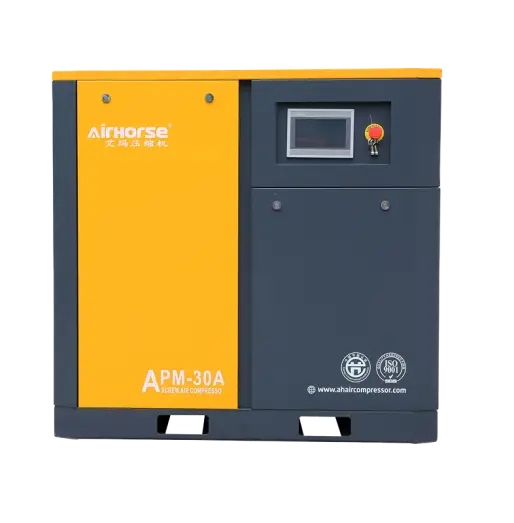
High Efficiency of Energy Saving
Cost Effective
High Reliability
Low Maintenance Rate
Smooth Soft Start
The maximum starting current is limited to within 1.6 times the rated current. In comparison, traditional frequency start methods typically have a maximum starting current up to 6 times the rated current. The AirHorse screw inverter compressor significantly reduces the starting inrush current, lowering the load on the transformer and ensuring the safety of the motor.
Efficient Inverter Technology : The inverter compressor starts with a very low starting current—less than 1.6 times the rated current—without requiring regular loading and unloading cycles. It automatically adjusts the motor speed based on air consumption, ensuring energy efficiency and optimizing performance.The longer the inverter operates, the longer the equipment’s lifespan and the less maintenance is required. Additionally, it offers easy control through the internet, enabling automated production management.
Improve the output frequency to Improve working efficiency.
The inverter uses an over-modulation technique to ensure sufficient torque output even when the AC voltage is slightly lower, allowing the drying motor to operate effectively under varying voltage conditions. If the AC voltage is higher than normal, the inverter prevents excessive voltage output to the motor, thereby protecting the motor from high-voltage damage and ensuring stable performance.
Automotive
Construction
Beverage
Power Plants
Heavy Construction
Electronics
A 90kW servo inverter screw air compressor running at 0.7 MPa consumes only 58.68 kW power, compared to 75.1 kW by a regular inverter compressor and 99 kW by a non-inverter screw compressor. This results in energy savings of 16.42 kW/hour (20% more efficient than inverter) and 40.32 kW/hour (40% more efficient than non-inverter). Over 14 hours daily and 240 days yearly, it saves up to $10,482 against inverter and $25,727 against non-inverter compressors at an energy rate of $0.19 per kWh.
| Power (kW) | Energy Saved (kWh) |
|---|---|
| 18.5 | 51,800 |
| 22 | 61,600 |
| 37 | 103,600 |
| 45 | 126,000 |
| 55 | 154,000 |
| 75 | 210,000 |
| 90 | 252,000 |
| 110 | 308,000 |
| 132 | 369,600 |
| 160 | 448,000 |
Piping Material Features Comparison |
|||
| Piping Features | Stainless Steel(Type 304L) | Mild Steel | Blue anodized Aluminum Alloy |
| Weight (Dia 6inch, Length 6m) | 127.2 | 169.6 | 29.142 |
| Anti-Corrosive | Yes | No | Yes(100%) |
| Pressure drop (Dia 2 inch Length= 20m, Airflow=3 cubic metres/Minute, Pressure=10 bar) | 0.25 | 0.4 Bar | 0.1 |
| Efficient Energy Use | High | Low-moderate | High( Potential Cost savings of 34%) |
| Structural Durability | Very Strong | Very Strong | Strong |
| High Thermal Endurance | Yes | Yes | Yes |
| Installation Ease | Less Difficult | Difficult | Easy(High Flexibility and Modularity) |
| Simple Installation | Approx 6 feet length per hour | Approx 6 feet length per hour | Approx 45 feet Length per hour |
| Manpower and Work Hours Needed for 2″ Pipe Over 3000 Feet | Approx 600 man-hours/8 men for 2 weeks | Approx 600 man-hours/8 men for 2 weeks | About 100 man-hours with 8 workers, completed in under 2 days |
| Annual Charges for Installation, Commissioning & Operation | Approx 3000 dollars | Approx 7820 dollars | Approx 1300 dollars |
| Installation Cost Breakdown: Material % / Labor % | 30% / 70% | 25% / 75% | 80% / 20% |
| Texture of Surface | 0.03 | 0.05 | 0.001 |
| Required Specialized Tools: Welder, Threader, Groove Cutter | Yes | Yes | No |
| Quality of Air | High — When needed, these pipe systems comply with ISO 8573-1:2010 air quality standards | Low( Not according to !SO 8573-2010 air quality standards) | High — These pipe systems support compliance with ISO 8573-1:2010 air quality standards when required. |
| Cost Rate per Meter | Almost 2 less than Aluminum | 3 Times less than Aluminum | 163.64 Dollars |
| Service Life Depends on Environment, Pipe Design, and Grade | 30 years | 40 years | 20 years |
| Upfront Installation Cost | Material : 30% Labor:70% | Material : 25% Labor:75% | Material : 80% Labor:20% |
| Care and Maintenance | Difficult — Rust buildup under pipes and fittings can reach machinery, requiring weekly preventive maintenance. | Difficult (Accumulation of rust under pipes and fittings which travels to machinery may require preventive maintenance every 3-4 days) | Easy — No rust buildup, with preventive maintenance needed every 4 weeks. |